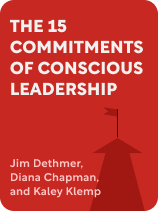

This article is an excerpt from the Shortform book guide to "The 15 Commitments of Conscious Leadership" by Jim Dethmer, Diana Chapman, and Kaley Klemp. Shortform has the world's best summaries and analyses of books you should be reading.
Like this article? Sign up for a free trial here.
What are the 15 commitments of conscious leadership? What leadership model can help organizations grow?
In The 15 Commitments of Conscious Leadership, Jim Dethmer, Diana Chapman, and Kaley Kemp present 15 commitments that conscious leaders must uphold to run an effective organization. They explain what each behavior is, why it’s important, and how to put it into action.
Read below for a brief overview of this must-have management book.
The 15 Commitments of Conscious Leadership
In The 15 Commitments of Conscious Leadership, Jim Dethmer, Diana Chapman, and Kaley Klemp argue that many leadership models are unsustainable because they fail to prioritize self-management and maintaining a healthy work-life balance. This causes leaders to burn out, lose their passion, and succumb to an unhealthy culture of competition and greed. As a result, employees become disengaged and unhappy, turnover soars, and organizations break down from within.
(Shortform note: As well as damaging workplace stability and causing unhappiness in leaders and employees alike, poor leadership models may have the arguably more severe effect of damaging health. Some research suggests that having a poor manager can trigger physical health issues among employees—for instance, heart attacks and headaches. In fact, more than 120,000 deaths per year in the US may be linked to bad management. Burned-out managers may face severe health risks, too: Some studies have linked burnout to increased mortality in people aged under 45, as well as an increased risk of type 2 diabetes, coronary heart disease, insomnia, and many other health conditions.)
To overcome these issues, the authors argue, organizations must implement what the authors call conscious leadership models. Leaders must:
- Learn to understand and manage their emotions and mindset
- Communicate effectively with others
- Align their actions and behaviors with their goals and commitments
Dethmer is a speaker and coach who specializes in conscious leadership. He’s worked with over 150 CEOs and teams to improve their leadership abilities and organizational health. He’s also a co-author of High Performing Investment Teams.
Chapman is a leadership advisor who’s worked with over 1,000 leaders and teams. She’s also a speaker, featuring at TEDx, Mindful Leadership Summit, Wisdom 2.0, and more. Dethmer and Chapman are co-founders of The Conscious Leadership Group.
Klemp is a speaker, a Young Presidents’ Organization (YPO) Forum Facilitator, and an executive coach who teaches leaders how to face challenges and reach their goals. She’s also the author of 13 Guidelines for Effective Teams and the co-author of The Drama-Free Office.
Behavior #1: Take Accountability
First, the authors argue that to be an effective leader, you must take total accountability, especially when things don’t go to plan—whether that’s due to your actions, the actions of your team, or other factors. Taking accountability empowers you to see that your actions influence your circumstances, meaning you’re the one with the ability to enact change and do better in the future. It also helps you avoid harmful behaviors like blaming and shaming others when things go wrong, ensuring your team culture remains collaborative.
Behavior #2: Be Open-Minded
The authors argue that to be an effective leader, you must also be willing to change your beliefs, admit when you’re wrong, and listen to opposing perspectives. This open-mindedness will help you gain a more accurate and complete view of reality, aiding problem-solving and decision-making.
Further, open-mindedness is important for managing relationships. Being closed-minded leads to defensiveness. It can make you see people who don’t align with your perspective as enemies. This causes a workplace culture of competition and polarization, which ultimately leads to the deterioration of relationships, low employee satisfaction, and increased employee turnover.
Behavior #3: Understand and Manage Your Emotions
Third, the authors argue, you must understand and healthily manage your emotions. Failing to do so might lead you to repress and intensify your feelings, which can harm your well-being.
How to Understand and Manage Your Emotions
To fully understand and manage your emotions, the authors recommend taking four steps:
Step #1: Understand What Emotions Are
First, understand what emotions are: ever-changing physical sensations that don’t define you, aren’t inherently “bad” or “good,” and aren’t something to fear. The authors explain that accepting these truths can help you resist the urge to repress your emotions—something many people do because they see certain feelings as “bad” or “inappropriate.”
Step #2: Know the Main Emotions
Second, know the five main emotions: being happy, unhappy, scared, mad, and sexually aroused. The authors note that all other feelings stem from, are variations of, or are combinations of these emotions. Learning the main emotions is necessary because you must identify which emotion you’re feeling before you can perform the next two steps of emotional management—releasing the emotion and interpreting it.
Step #3: Release Emotions Through Action
Third, the authors suggest releasing your emotions by completing an action that aligns with and expresses what you’re feeling. Start by identifying where you’re feeling the emotion in your body—for example, being scared might feel like your heart is being squeezed. Then, take deep breaths. Finally, use an intuitive movement to release your feelings by listening to what the emotion is telling you to do. For example, fear might push you to do a loose, expressive movement to overcome the tightness in your chest—you might stretch or do some jumping jacks.
Step #4: Interpret Your Emotions
Finally, the authors recommend figuring out what your emotion is trying to tell you. Being mad means that something isn’t right and must be replaced or improved. Being scared means that you must learn a new skill to overcome whatever is threatening you. Being unhappy means that you’re losing something meaningful and you have to accept it and let it go. Being happy means that something needs to be celebrated. Being sexually excited indicates creativity and should inspire collaboration with others.
Behavior #4: Be Authentic
Next, the authors argue that effective leaders must be authentic. This involves expressing your true thoughts and feelings, addressing problems honestly and directly with the people involved, and upholding your commitments: actions that improve team cohesion and reduce the likelihood of interpersonal conflict.
How to Be Authentic
Let’s dive deeper into two of the elements of authenticity: addressing problems honestly and directly with the people involved, and upholding your commitments.
Element #1: Address Issues Honestly and Directly
First, the authors note, being authentic requires you to address issues honestly and directly with the people involved. To do so, initiate a conversation with the other party. Bring up the issue, expressing that your intention is to preserve your good relationship, and ask when might be a good time to talk about the situation in detail.
When it’s time for your in-depth conversation, list the objective facts of what happened, and then explain your thoughts, feelings, and judgments about those facts. For example, you might say, “I noticed that while I was sharing my report, you were working on your laptop rather than listening to me. This made me feel angry and worried that you don’t see my work as valuable.”
To close, admit your role in creating the difficult situation and present your solution. For example, you might conclude by saying, “Perhaps I should’ve clarified what my expectations are for how people follow along with my presentations. Next time, I’ll do this before I start my presentation.”
The authors warn to avoid gossiping—discussing an issue with people not involved, and talking about those involved in a pejorative way. This perpetuates the original issue and can create more conflict in the long run.
Element #2: Uphold Your Commitments
The authors explain that being authentic also requires you to uphold the commitments you make to others. They present three guidelines for doing so:
1) When making a commitment, be clear about what each person will do and when they’ll do it—including yourself. Ensure that everyone involved will uphold their commitment.
2) If you realize you can’t uphold your original commitment, tell the rest of the group immediately. If possible, adjust what you’ll do and when you’ll do it.
3) Resolve past broken commitments by acknowledging your failure to the people involved and asking if there’s a way you can fix it.
Behavior #5: Practice Gratitude
The authors argue that effective leaders must also practice gratitude. This involves being grateful for everything that comes your way and accepting gratitude from others.
Practicing gratitude may help you to focus more on what you have, rather than on what you want. This can prevent jealousy, competition, and dissatisfaction—things that ultimately lead to conflict with your colleagues.
How to Practice Gratitude
To practice gratitude, the authors recommend paying attention to and celebrating even the smallest positive aspects of the things and people around you. For instance, if a subordinate submits a report, appreciate not just the whole piece, but the careful construction of each sentence and the clarity of the conclusion. This will give you more aspects of something to be grateful for; and, the more you express gratitude for things, the more valuable they’ll feel to you.
Further, express gratitude to others. The authors explain that effectively expressed gratitude has a few components: Your statement must be genuine, reference the specific details you’re grateful for, and use as few words as possible. That way, the other person will quickly understand exactly what you appreciate and why. They’ll also see you as more sincere—rambling on can make people doubt you’re being serious.
Finally, accept gratitude from others. The authors recommend thinking of gratitude as a present—if someone gave you a present, it would be rude to refuse it.
Behavior #6: Reach Your Full Potential
Another behavior of effective leaders is reaching your full potential. The authors note that this means doing work that you love, that comes naturally to you, and that utilizes your unique skills and abilities. Leaders who reach this state maximize their creativity and motivation, producing high-quality work for their organization.
Behavior #7: Prioritize Happiness and Positivity
Next, the authors argue that to be an effective leader, you must prioritize happiness and positivity. Doing so will help you avoid stress, increase your energy, and maximize your effectiveness.
How to Prioritize Happiness and Positivity
The authors suggest a few methods for prioritizing happiness and positivity.
Method #1: Find Contentment Within Yourself
The authors explain that many leaders struggle to feel happy in life because, like many humans, they believe they lack three things: safety, acceptance, and power. They therefore seek these three things externally—for instance, they try to gain safety by acquiring financial power over others, or they prioritize getting rich so they can feel accepted by their community.
However, believing you lack these factors and chasing them externally doesn’t lead to happiness. Instead, it causes dissatisfaction, stress, and suffering. This is because true contentment comes from recognizing you already have these things within you—you don’t “lack” anything at all.
Finding contentment within is the only way to achieve authentic, long-lasting happiness. To do so, acknowledge the external factors you seek (such as power over others or wealth), and then simply release these wants—try to exist in the moment as a person with no wants. Once you reach this state, acknowledge that you and your life are enough: It was only your wants that caused dissatisfaction. Once you release wants, you can feel content just with yourself.
Method #2: Have Fun and Go With the Flow
The authors explain that having fun and going with the flow also helps you feel more happy and more content in life. Having fun (what the authors call “play”) involves making time to do seemingly meaningless activities for the sake of enjoyment. Going with the flow means accepting rather than resisting uncontrollable circumstances in your life—acknowledging that they happen, and deciding how to move forward with creativity and flexibility to joyfully build upon what life gave you.
Method #3: Actively Change Things You Dislike
The authors explain that taking action to change things that you find unsatisfactory is key to developing a positive mindset. Many people see flaws in the world around them—whether in their relationships, their work, or society at large—and complain rather than taking action to improve things. This encourages the negative belief that things are imperfect and always will be. Instead, view imperfections as things you can change and opportunities to make the world a better place.
Behavior #8: Adopt a Mindset of Abundance
Finally, the authors argue that you must adopt a mindset of abundance to be an effective leader. In other words, believe that there are enough external resources (jobs, money, and so on) to go around—specifically, enough resources to make everyone happy.
In contrast, leaders with scarcity mindsets believe that there aren’t enough external resources to go around. Therefore, they believe that instead of collaborating with others, they must greedily compete with and triumph over them to survive and thrive.

———End of Preview———
Like what you just read? Read the rest of the world's best book summary and analysis of Jim Dethmer, Diana Chapman, and Kaley Klemp's "The 15 Commitments of Conscious Leadership" at Shortform.
Here's what you'll find in our full The 15 Commitments of Conscious Leadership summary:
- Why many leadership models are unsustainable in the long term
- Why leaders must learn to understand and manage their emotions
- The 15 commitments that leaders must uphold to run an effective organization






